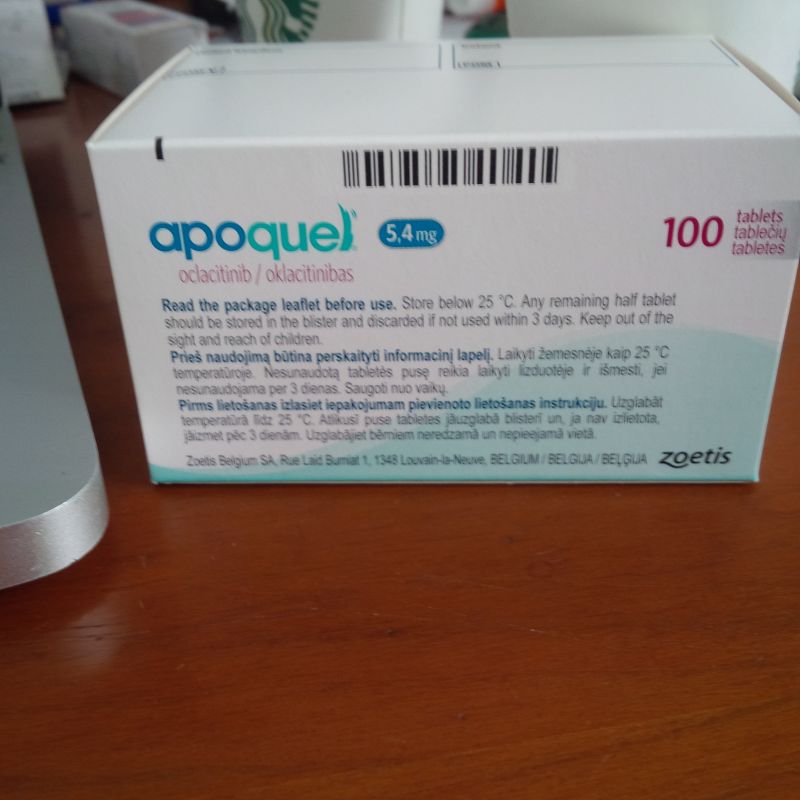Zoetis Apoquel (Oclacitinib tablet)
Apoquel is an extremely promising new drug aimed at treating the discomfort which is seen in allergic skin disease, especially when that relates to airborne or environmental allergens. Early reports on its use are especially encouraging and sometimes quite dramatic. Vets will prescribe it particularly to treat atopic dermatitis or atopy, which is a common cause if itchiness and discomfort found in dogs which are reacting to house dust and house dust mites, as well as other triggers of allergic skin disease found in the environment. Apoquel can also be used to reduce the itching seen in dogs with other forms of skin allergy, but food elimination trials and treating for parasites (particularly fleas) is strongly recommended. It is also important to make sure that no skin infection is present, so a course of antibiotic might be given too.
Apoquel tablets are given twice daily initially, reducing to once daily after 14 days. Quite often a short course of tablets is all that is needed to control symptoms, but some dogs will go onto once daily dosing for a much longer period. Apoquel tablets suppress a specific part of the immune response in order to work. This is not usually associated with any side effects, but it is possible to see vomiting and diarrhoea, as well as a number of other effects. It is possible that the response to vaccination might be reduced if a vaccine is given while Apoquel tablets are being taken. These factors need to be taken into account, especially if long term use is intended.
Presentation
- Apoquel tablets contain 3.6, 5.4 or 16 mg oclacitinib (as oclacitinib maleate). Each tablet is marked with “AQ” on one side, with “S”, “M” or “L” on the other side referring to the tablet strengths.
Uses
Indicated for the treatment of pruritus associated with allergic dermatitis and the clinical manifestations of atopic dermatitis in dogs.
Dosage and administration
For oral use.
Dosage and treatment schedule
The recommended initial dose is 0.4 to 0.6 mg oclacitinib/kg bodyweight, administered orally, twice daily for up to 14 days.
For maintenance therapy, the same dose (0.4 to 0.6 mg oclacitinib/kg bodyweight) should then be administered only once a day. The requirement for long-term maintenance therapy should be based on an individual benefit-risk assessment.
Apoquel can be administered with or without food.
The dosing table below shows the number of tablets required. The tablets are breakable along the score line.
Bodyweight (kg) of dog
Strength and number of tablets to be administered.
Initial dose (twice daily) / Maintenance therapy (once daily)
3.6 mg
tablets
5.4 mg
tablets
16 mg
tablets
3.0 – 4.4
½
4.5 – 5.9
½
6.0 – 8.9
1
9.0 – 13.4
1
13.5 – 19.9
½
20.0 – 26.9
2
27.0 – 39.9
1
40.0 – 54.9
1½
55.0 – 80.0
2
Contra-indications, warnings, etc
Do not use in cases of hypersensitivity to the active substance or to any of the excipients.
Do not use in dogs less than 12 months of age or less than 3 kg bodyweight.
Do not use in dogs with evidence of immune suppression, such as hyperadrenocorticism, or with evidence of progressive malignant neoplasia as the active substance has not been evaluated in these cases.
The safety of Apoquel during pregnancy, lactation or in dogs intended for breeding has not been established, so its use is not recommended.
Oclacitinib modulates the immune system and may increase susceptibility to infection and exacerbate neoplastic conditions. Dogs receiving APOQUEL tablets should therefore be monitored periodically with complete blood counts and serum biochemistry when on long-term treatment.
When treating pruritus associated with allergic dermatitis with oclacitinib, investigate and treat any underlying causes (e.g. flea allergic dermatitis, contact dermatitis, food hypersensitivity). Furthermore, in cases of allergic dermatitis and atopic dermatitis, it is recommended to investigate and treat complicating factors, such as bacterial, fungal or parasitic infections/infestations (e.g. flea and mange).
The common adverse reactions seen up to day 16 of the field trials are listed in the following table and compared to placebo:
Adverse reactions observed in atopic dermatitis study up to day 16
Adverse reactions observed in pruritus study up to day 7
APOQUEL
(n=152)
Placebo
(n=147)
APOQUEL
(n=216)
Placebo
(n=220)
Diarrhoea
4.6%
3.4%
2.3%
0.9%
Vomiting
3.9%
4.1%
2.3%
1.8%
Anorexia
2.6%
0%
1.4%
0%
New cutaneous or subcutaneous lumps
2.6%
2.7%
1.0%
0%
Lethargy
2.0%
1.4%
1.8%
1.4%
Polydipsia
0.7%
1.4%
1.4%
0%
After day 16, abnormal clinical signs, in addition to those clinical signs listed above and occurring in greater than 1% of the dogs receiving oclacitinib included pyoderma, non-specified dermal lumps, otitis, histiocytoma, cystitis, yeast skin infections, pododermatitis, lipoma, lymphadenopathy, nausea, increased appetite and aggression. In a laboratory study, the development of papillomas was noted in a number of dogs.
Treatment related clinical pathology changes were restricted to an increase in mean serum cholesterol and a decrease in mean leukocyte count, however, all mean values remained within the laboratory reference range. The decrease in mean leukocyte count observed in oclacitinib-treated dogs was not progressive, and affected all white blood cell counts (neutrophil, eosinophil and monocyte counts) except lymphocyte counts. Neither of these clinical pathology changes appeared clinically significant.
No drug interactions were observed in field studies where oclacitinib was administered concomitantly with veterinary medicinal products such as endo- and ectoparasiticides, antimicrobials and anti-inflammatories.
The impact of oclacitinib administration on vaccination with modified live vaccines, canine parvovirus (CPV), canine distemper virus (CDV) and canine parainfluenza (CPI) and inactivated rabies vaccine (RV), on 16 week old vaccine naïve puppies has been studied. An adequate immune response (serology) to CDV and CPV vaccination was achieved when puppies were administered an overdose of oclacitinib at 1.8 mg/kg bodyweight twice daily for 84 days. However, the findings of this study indicated a reduction in serological response to vaccination with CPI and RV in puppies being treated with oclacitinib compared to untreated controls. The clinical relevance of these observed effects for animals vaccinated while being administered oclacitinib (in accordance with the recommended dosing regimen) has not been established.
Oclacitinib tablets were administered at 1x, 3x and 5x to healthy, one year old Beagle dogs twice daily for 6 weeks followed by once daily for 20 weeks.
Clinical observations that were considered likely to be related to oclacitinib treatment included: alopecia (local), papilloma, dermatitis, erythema, abrasions and scabbing/crusts, interdigital "cysts", and oedema of the paws. Dermatitis lesions were mostly secondary to the development of interdigital furunculosis on one or more paws during the study; the number and frequency of observations increased with increasing dose. Lymphadenopathy of peripheral nodes was noted in all groups and increased in frequency with increasing dose, and was frequently associated with interdigital furunculosis. Papilloma was considered treatment related, but not dose related.
There is no specific antidote and in case of signs of overdose the dog should be treated symptomatically.
Further information
Oclacitinib is a Janus kinase (JAK) inhibitor. It can inhibit the function of a variety of cytokines dependent on JAK enzyme activity. For oclacitinib, the target cytokines are those that are proinflammatory or have a role in allergic responses/pruritis.
Following oral administration in dogs, oclacitinib maleate is rapidly and well absorbed, with a time to peak plasma concentration (tmax) of less than 1 hour. The absolute bioavailability of oclacitinib maleate was 89%.
Total body oclacitinib clearance from plasma was low; 316 ml/h/kg bodyweight (5.3 ml/min/kg bodyweight), and the apparent volume of distribution at steady-state was 942 ml/kg bodyweight. Following intravenous and oral administration, the half-lives were similar at 3.5 and 4.1 hours respectively. Oclacitinib exhibits low protein binding.
Overall the major clearance route is metabolism, with minor contributions from renal and biliary elimination. Inhibition of canine cytochrome P450s is minimal. Therefore, the risk of metabolic drug-drug interactions due to oclacitinib inhibition is very low. No accumulation was observed in the blood of dogs treated for 6 months with oclacitinib.
Content edited with the 4html.net free online editor. Read more: online HTML converter


